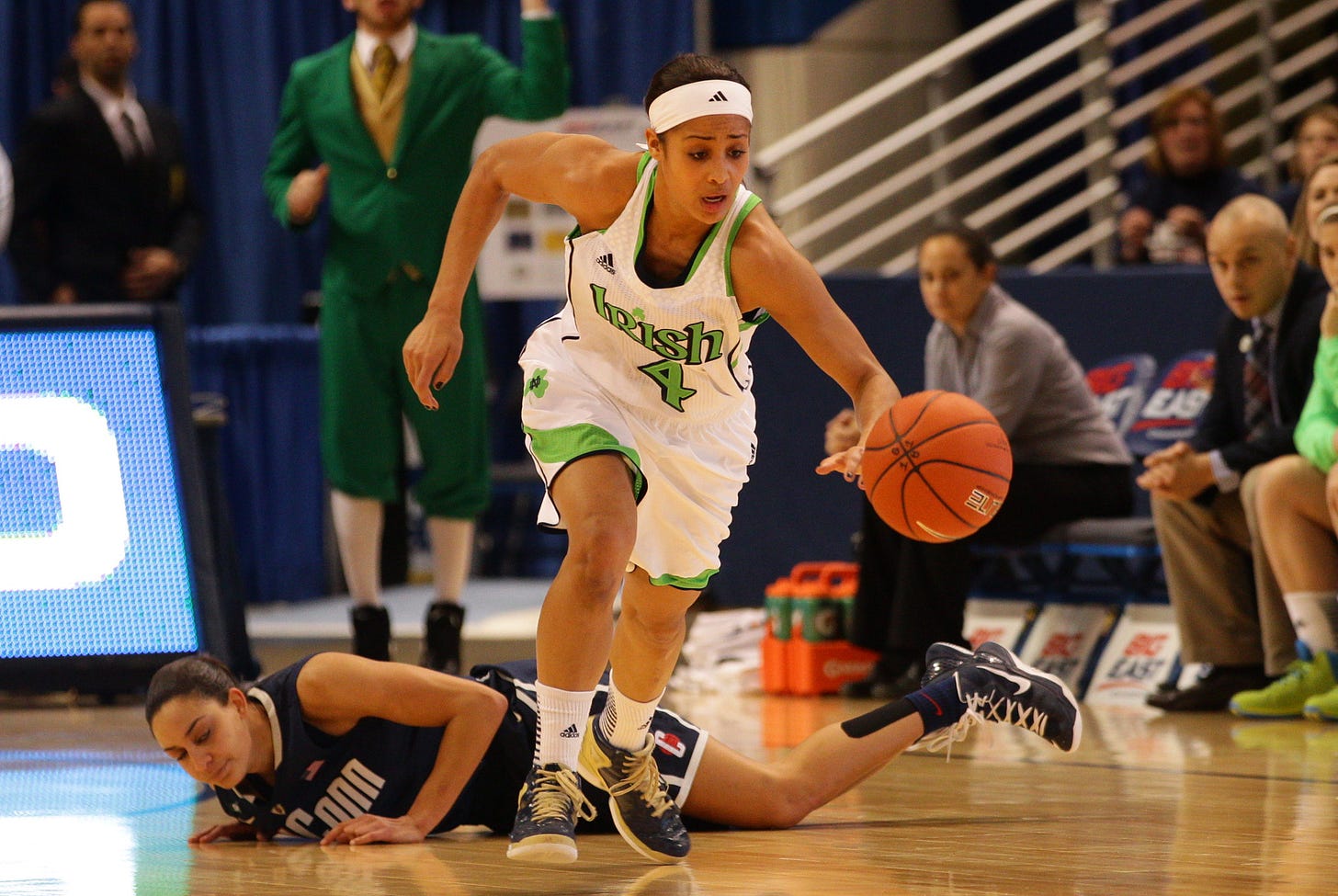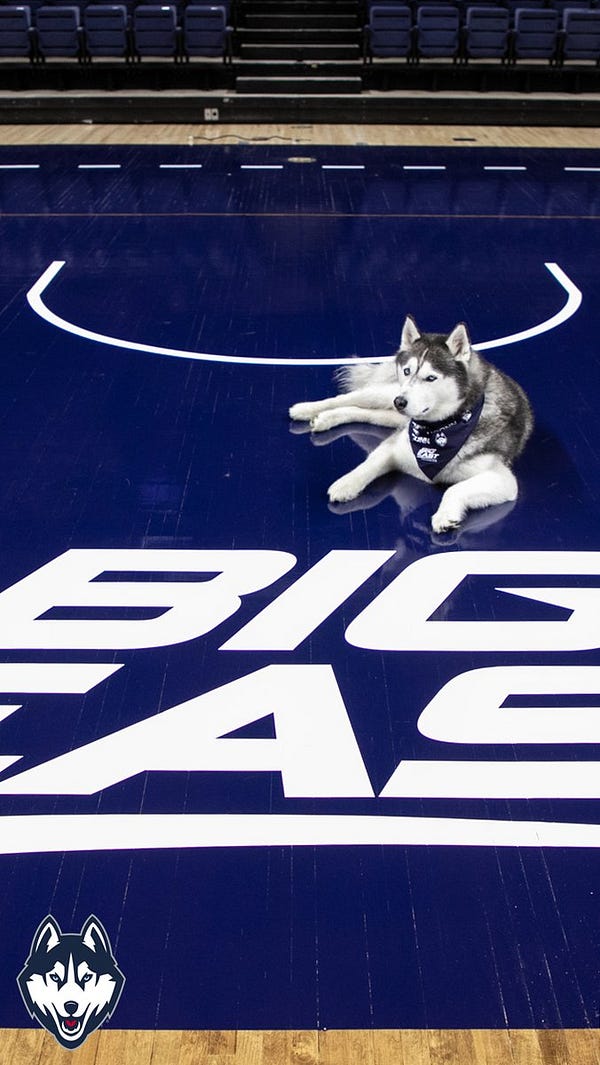UConn ended its previous run in the Big East on a skid. How has the conference evolved since then?
2020 Big East women's basketball media day is on Thursday, so we look back at how the conference came to its current iteration.
Welcome to the UConn WBB Weekly, a recap of everything that happened in the world of UConn women’s basketball over the past week from the team that runs The UConn Blog and Storrs Central.
Subscribe to get the Weekly in your inbox every Thursday and if you enjoy it, make sure to send it to all your fellow Husky diehards.

Photo by Tim Clayton/Corbis via Getty Images.
Top Links
From The UConn Blog and Storrs Central:
UConn women’s basketball schedule tracker — New dates for Tennessee, Baylor
2021 No. 1 recruit Azzi Fudd down to four schools — Updated with new info about her final schools (one of which is UConn).
Note to readers: Today (Thursday, Oct. 29) is Big East women’s basketball media day. The conference will announce the coaches’ poll, preseason awards and possibly a schedule for December at 9 a.m. Beginning at 10 a.m., we’ll hear from commissioner Val Ackerman along with the rest of the conference’s head coaches. Geno Auriemma is expected to take the virtual podium around 12:30 p.m.
Follow along throughout the day on Twitter with me (@DanielVConnolly) and Megan Gauer. We’ll update this stream with news and stories as well.
Last week’s Weekly:
Elsewhere
Newcomer Impact Rankings: Which women’s college basketball freshmen, transfers will influence 2020-21? (ESPN) — Paige Bueckers, Evina Westbrook and Aaliyah Edwards all mentioned.
Geno Auriemma Supports New Program to Further Boost UConn Grad Students at the Recruiting Table (UConn Today)
Ten NCAA Teams Changing Conferences or Reclassifying to Division I (Her Hoops Stats) — Includes UConn’s move to the Big East
Renee Montgomery seems unlikely to return to Dream in free agency (AJC)
In The News
UConn adds two more 2022 targets
The Huskies made the list of two 2022 prospects off the beaten path. Imani Lester, a 6-foot-3 post player out of Raleigh, North Carolina, included UConn in her top 12 which also notably featured Louisville, Mississippi State, NC State and UNC. ESPN rated her as the ninth-best post player in the class, though she wasn’t included in their top 60 prospects.
Canadian guard T’yana Todd listed UConn in the final 16 which also featured Mississippi State, Louisville, South Carolina and Texas, to name a few. She isn’t listed in ESPN’s recruiting database at the moment.
UConn is connected with four other 2022 prospects at the moment: Lauren Betts (the No. 1 in the class), Ayanna Patterson (No. 3), Kiki Rice (No. 6) and KK Bransford (No. 27). The Huskies already have one commit in the class: Isuneh Brady, a 6-foot-3 post ranked as the fifth-best 2022 prospect by ESPN.
Huskies lock down two more dates on the schedule
UConn’s non-conference schedule is nearing completion as two more dates were added to its slate this past week. The Huskies will hit the road to play Baylor on Jan. 7 and will travel to Knoxville to face Tennessee on Jan. 21 — the date originally announced by the Hall of Fame in June. Now, UConn’s matchup with South Carolina is the Huskies’ only non-conference game without a date.
Keep track of all the latest news and rumors about UConn’s schedule with our tracker.
How the Big East has changed since 2013
With the Big East holding its women’s basketball media day on Thursday, we’re looking back at how the conference has evolved since the 2012-13 season when UConn last called it home.
Whenever UConn women’s basketball opens Big East play this season, it’ll be looking to prevent a losing skid in the conference. The Huskies’ last game in the Big East — way back on March 12, 2013 — was a 61-59 loss to Notre Dame in the conference tournament championship game. In fact, UConn went just 2-2 in its final games in the Big East.
Safe to say plenty has changed since then.
Following the 2012-13 season, the old Big East collapsed. The conference lost its four best programs — UConn, Notre Dame, Louisville and Syracuse — along with Rutgers, USF, Cincinnati and Pitt. Left were DePaul, Georgetown, Marquette, Providence, Seton Hall, St. John’s and Villanova.
In the span of one offseason, the Big East went from being one of the nation’s best women’s basketball conferences to an unproven mid-major.
In response to the exodus, the conference added Butler, Creighton and Xavier — three programs with varying levels of success. Xavier is the best of the bunch with two Elite Eight appearances (2001, 2010) and 13 conference titles (all before the Big East) to its name. Creighton made four NCAA Tournaments in the 2010s and has been to seven total, though the Bluejays have never advanced past the second round. Butler, meanwhile, has one tournament bid in program history — way back in 1993.
In the new Big East, DePaul took over as the team to beat. The Blue Demons are a perennial NCAA Tournament team under head coach Doug Bruno with 17 consecutive appearances and claimed all but one regular season crown and five of seven conference tournament championships — including the last three.
Marquette is the only other program to win a regular season title, doing so in 2019 and also captured the 2017 Big East Tournament. St. John’s won the tournament in 2016.
In the NCAA Tournament, the Big East has sent at least two schools each year — with a high of four teams in the field in 2018. DePaul qualified each season but behind it, Marquette has three appearances, Creighton, Seton Hall and St. John’s have two apiece and Villanova has one.
For reference: Excluding UConn, the AAC saw just four different schools qualify for the NCAA Tournament and never had more than two members reach it in a given year.
However, though the Big East has consistently placed teams into the NCAA Tournament, it doesn’t have much success to show for it. No team has been higher than a five seed while DePaul is the only school to advance beyond the first weekend.
In short: UConn isn’t re-joining the powerhouse Big East of old, but the current iteration has proven itself to be a strong mid-major conference and is a clear step up in competition from the AAC. The difference may not necessarily manifest itself in the Huskies’ win-loss record — Auriemma’s teams have just three losses to current Big East opponents since 1994 — but they’ll be challenged on a more frequent basis.
Take last season for example. On the road at Seton Hall, UConn trailed by nine at halftime and needed a 25-point, 12-rebound performance from freshman Aubrey Griffin. Later on against DePaul, the Huskies saw a 26-point halftime lead evaporate as the Blue Demons got within four points in the fourth quarter before a late push from UConn got them the win.
In the American, just three games over the span of seven years were even within single-digits. The Huskies’ 40+ point victories in conference play won’t completely disappear, but they’ll be far less frequent.
On top of that, there’s hope that UConn’s return could boost the rest of the Big East and help some of the better programs — Creighton, DePaul, Marquette, St. John’s, Seton Hall — take the next step. The Huskies’ presence never did that for the AAC, but maybe UConn is the spark the Big East needs.
We looked at the difference between Big East and AAC women’s basketball more in-depth when UConn announced its move in June 2019 and broke down Big East women’s basketball team-by-team this past summer. We also recapped everything that went into UConn’s return to the Big East.
Best of social media
Introducing UConn’s freshman class:
Interesting perspective from Napheesa Collier on her freshman season:
?igshid=1nv9c3q9686to
Some very important content:





It’s spooky season:
History Corner
UConn’s last loss to a current Big East opponent came on Senior Day 2012 to St. John’s, a 57-56 defeat. Though the Red Storm weren’t a bad team — they finished 24-10 and reached the Sweet Sixteen — that game remains one of the most baffling losses in Auriemma’s career.








